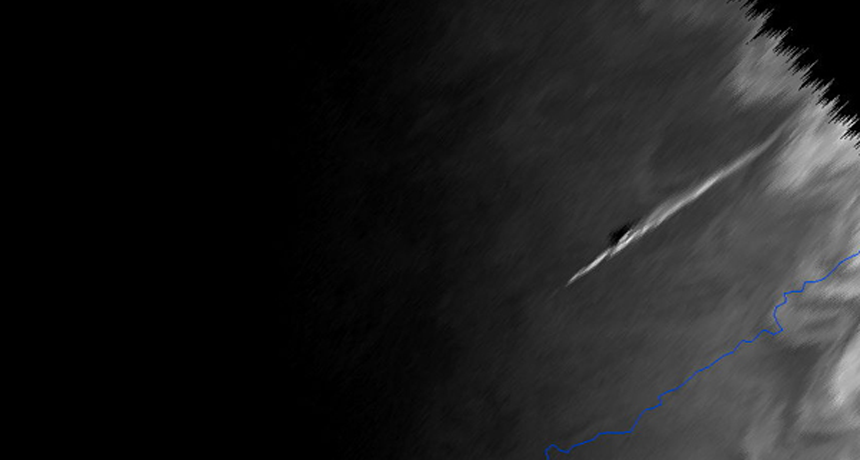Meteor explodes over Russia
Surprise: No one saw it coming

This streak of light shows the meteor’s entry into Earth’s atmosphere. The image was captured by a European weather satellite.
EUMETSAT
By Janet Raloff
Mother Nature provided a surprise light show over Russia early on February 14. That’s when a major meteor entered Earth’s atmosphere. The object was originally 17 meters (55 feet) in diameter. That’s as wide as a 5-story building is high. It had also weighed a whopping 10,000 metric tons, according to the National Aeronautics and Space Administration (NASA).
The meteor was traveling about 65,000 kilometers (40,000 miles) per hour. It created a brilliant streak as it traveled across the sky for nearly 33 seconds. The meteor then exploded about 20 to 25 kilometers (12 to 15 miles) above Earth’s surface.
When the meteor exploded, it created a flash brighter than the sun. The explosion released nearly 500 kilotons of energy. That’s about 70 times as much energy as was released just a few days earlier when North Korea tested a nuclear bomb.
NASA maintains an orbital debris office in Texas. It tracks anything that might damage satellites or knock them out of orbit. Asteroids and other rocky objects sailing through space are prime candidates. In fact, on the day the Russian meteor hit, NASA and a number of other space centers around the world had been tracking a very different space rock. Experts were watching for an asteroid called 2012 DA14, about 50 meters (164 feet) in diameter. It was due to pass very close to Earth — within 27,000 kilometers (about 16,800 miles) — later on the same day. While the scientists were watching for DA14, the meteor that broke up over Chelyabinsk, Russia, caught them by surprise.
Astronomers rely on telescopes to view such objects approaching from space. But those objects must reflect sunlight for scientists to see them, Margaret Campbell-Brown explained to Science News. She’s an astronomer at Canada’s Western Ontario University in London. The Russian meteor approached Earth from a sunward direction. That means the sun’s reflection would be on the side of the meteor facing away from Earth. So it escaped detection until it began racing through Earth’s atmosphere. At that point, the meteor was impossible to miss. It created a fireball and multiple thunderous sonic booms.
A special microphone network that picks up infrasound — sound below the threshold of human hearing — detected the incoming object long before anyone heard it. That infrasound pinpointed the breakup of the meteor just 32.5 seconds after entering Earth’s atmosphere.
The meteor’s breakup created shock waves, heard on the ground as sonic booms. The shock waves collapsed walls and shattered windows. Glass went flying. An estimated 1,200 Russians suffered cuts and other injuries.
NASA scientists estimate that a meteorite this big hits Earth about once every 100 years. This was the biggest to hit since a far larger meteorite hit in 1908. It also struck Russia.
Most of the recent meteor disintegrated in the atmosphere. Some fragments certainly survived the fall to Earth. Usually only about 1 to 5 percent of a meteor’s mass is found on the ground in the form of meteorites, according to the Russian Academy of Sciences.
Power Words
atmosphere The envelope of gases surrounding Earth or another planet.
debris Scattered fragments, typically of something wrecked or destroyed. Space debris includes the wreckage of defunct satellites and spacecraft.
friction The resistance to movement that occurs when two things — solids, gases, liquids or a combination of two of these — are in contact. Friction generally causes a heating, which can damage the surface of the materials rubbing against one another.
asteroid A small, usually rocky celestial body in orbit around the sun.
meteor An asteroid or other small celestial body from outer space that enters Earth’s atmosphere. The friction of the atmosphere causes intense heating that will cause a meteor to at least partially burn up or break apart. As a meteor passes through the atmosphere, it appears as a streak of light.
meteorite The remains of a meteor that reach the ground.
orbit The curved path of an object or spacecraft around a star, planet or moon.







